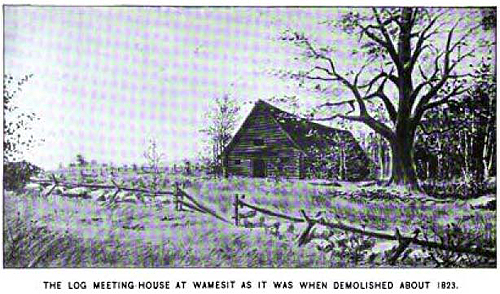Native Americans, Colonial Settlement, and the Concord River
Native American Settlements
Prior to the arrival of European colonists, many
generations of Native Americans inhabited the lower reaches of the
Concord River. Identified as members of the “Pennacook
Confederacy,” the various tribes in this region, including the “Wamesits”
and the “Pawtuckets,” shared a common language—an Algonquian
dialect—as well as many other cultural customs and kinship ties.
They cleared and cultivated the fertile lands, growing beans, corn,
squash, and pumpkins, hunted in the fields and forests, and fished
in the Concord and Merrimack rivers, abundant with salmon, alewives,
sturgeon, shad, and eels.

Constructed under the aegis of the Reverend John
Eliot, the “Meeting House” was the center of the “praying
village” at Wamesit. It stood for nearly 170 years before
being demolished in the 1820s. |
Early Colonists
Much of the early contact between Englishmen and Indians centered on
the trade for beaver skins and other animal pelts. This commercial
exchange intensified throughout much of the 17th century as European
demand for fur grew and pushed English traders ever deeper into the
hinterlands. As early as 1635, Simon Willard of Cambridge
established a trading post in the Musketaquid Valley, the Indian
name for grassy plain. A settlement the English called Concord took
root here. Willard and his fellow traders also journeyed along the
Concord River to its confluence with the Merrimack and beyond
Pawtucket Falls, north to the lake region of New Hampshire.
Hear Professor Chad Montrie highlight the major
Native American tribes and settlements along the Concord and
Merrimack rivers.
This text will be replaced with the video
|
Praying Village
By the late 1640s John Eliot, a clergyman from Roxbury and one of the few
Englishman who became proficient in the Algonquian language, had established
a series of “praying villages” to teach Native Americans the Christian
faith. One of these villages was located at Wamesit, an area extending on
both sides of the Concord River, west and north toward Chelmsford neck. On
a hill south of the Merrimack and west of the Concord, Eliot had a log
building constructed to serve as a meeting house and dwelling during his
visits to the Wamesit grant. Eliot’s ministerial labors among the Indians
helped bring about a longer-term native settlement at Wamesit. At the same
time, however, a growing number of whites claimed land and began to clear
and farm the area west of Wamesit. In 1652 about 20 of these settlers
petitioned the General Court to establish Chelmsford, which was granted the
following year. Relations between colonists and Native Americans, remained
relatively peaceful until the 1660s and 1670s, when even Eliot and English
settlers sympathetic to the Christianized Indians were unable to alleviate
a growing hostility that sparked a brutal and bloody conflict.
English Conquest
In addition to the violence and death suffered by colonists and natives alike,
one result of King Phillip’s War in 1675-76 was the ouster of Wamesit,
Pawtucket, and other members of the Pennacook Confederacy from Wamesit and the
surrounding area. About a dozen Englishman and their families quickly settled
on land along the Concord River and began farming, as well as raising
livestock. Over the next several generations more landholders and tenant
farmers took up residence in Chelmsford Neck and the area that was called East
Chelmsford prior to the establishment of Lowell in 1826.


